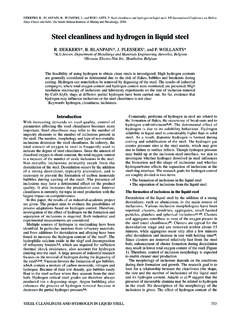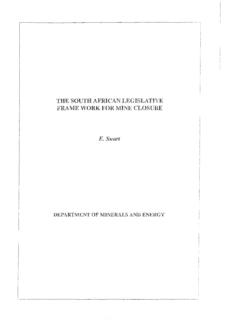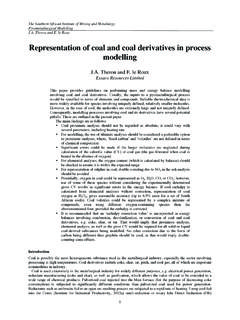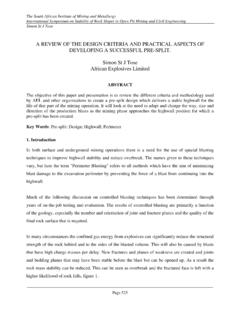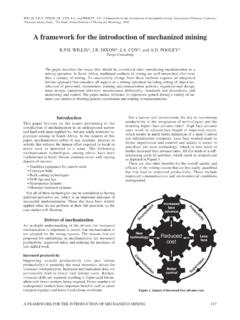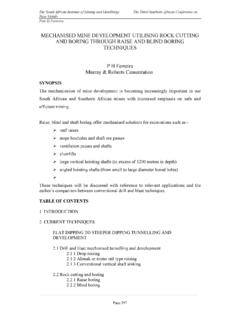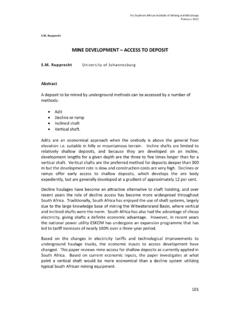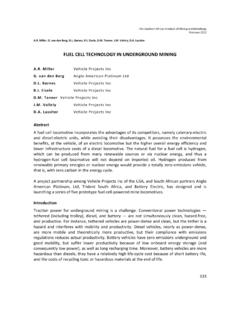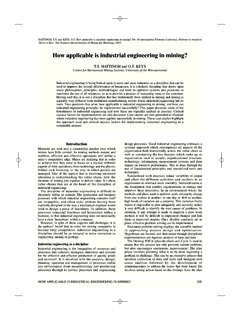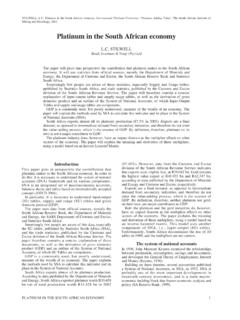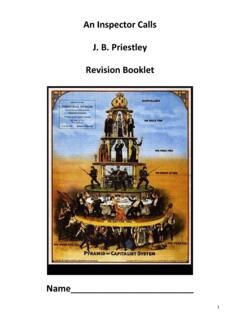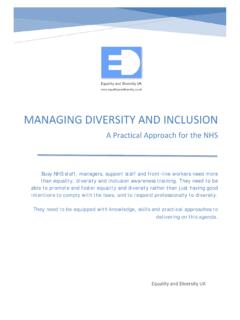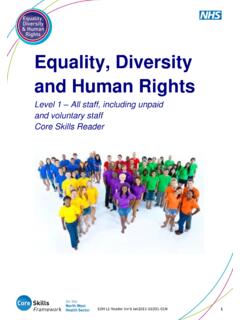Transcription of OCCUPATIONAL HEALTH AND SAFETY CONSIDERATIONS …
1 The Southern African Institute of Mining and Metallurgy Hard Rock Safe SAFETY Conference 2009 C J Badenhorst _____ Page 55 OCCUPATIONAL HEALTH AND SAFETY CONSIDERATIONS FOR THE EMPLOYMENT OF FEMALE WORKERS IN HARD ROCK MINES C J Badenhorst Anglo Platinum Abstract Until very recently Mining were male dominated industries and hostile to women s participation in work. Women were rarely employed in mining as it was considered to be highly male dominated activities and women were considered unfit for the hard labour of working in the mines and heavy industries.
2 In addition until the new Constitution and the MHSA, employment of females underground was prohibited through an ILO convention. Historically most of the jobs of women on mines related to either administrative or to menial lower rank activities like sweepers, cleaners or attendants in the offices. The personal protective equipment available was unsuitable for women posing significant risk of workplace injuries to women There is a duty of care to provide a safe system of work to women of reproductive age, their unborn children and all working mothers who are breastfeeding.
3 At the same time the right to equal opportunities and fairness must be recognised. Employment of woman in their productive years requires specific action to ensure that there is no significant risk of exposure that may effect reproduction, HEALTH and SAFETY before and during pregnancy, the unborn child as well as mother and child during breast feeding. 1 INTRODUCTION Background Until very recently Mining were a male dominated industry and hostile to women s participation in work. Women were rarely employed in mining as it was considered to be a highly male dominated activity and women were considered unfit for the hard labour of working in the mines.
4 Historically most of the jobs of women on mines and heavy industries related to either administrative or to menial lower rank activities like sweepers, cleaners or attendants in the administration offices. The personal protective equipment available was unsuitable for women posing significant risk of workplace injuries to women. Women's workplace HEALTH problems are frequently compounded by getting more of the same at home - the "double jeopardy" of domestic work, which can mean a second shift of lifting, responsibility and chemicals on top of those experienced all day at work.
5 There is a significant Industry concern about the potential effects of OCCUPATIONAL exposure to chemical substances, physical, ergonomic and biological hazards on reproductive outcomes. Besides the obvious physical and ergonomic risks of underground work and work in heavy industries, many chemical substances with reported reproductive and development effects are in regular use and thus present potential exposure to workers. In addition physical, ergonomic and biological hazards with reported reproductive and development effects are present in a number of workplaces and thus present potential exposure to workers.
6 The Southern African Institute of Mining and Metallurgy Hard Rock Safe SAFETY Conference 2009 C J Badenhorst _____ Page 56 Examples of these include heavy metals (lead), organic solvents, noise, vibration, radiation, etc. Absence of sufficient research data, including toxicological and epidemiologic data, lends a degree of uncertainty to the estimated magnitude of risk that a specific chemical substance or hazard presents. Nationally and internationally, progress has been limited in identifying hazards and quantifying their potencies and in separating the contribution of these hazards from other etiologic factors.
7 The pace of laboratory studies to identify hazards and to underpin the biological plausibility of effects in humans has not matched the pace at which new chemicals are introduced into commerce. In addition, the number of female workers of reproductive age potentially exposed to OCCUPATIONAL chemical and physical agents has grown. Men are different from women Men are different from women. That would seem to be self-evident. They are different in aptitude, skill and behavior, but then, so is every individual person. So why do we make such a fuss about it? Simply because of the fact that women are very different from men physically and biologically, and pertinently in one specific aspect - namely that they can fall pregnant and thus become two people that must be considered, the mother and the baby with very specific risk factors 2 LEGAL IMPLICATIONS When employing female employees in any work environment, there are a number of South African laws that do apply and that need to be considered by Employers.
8 These include, but are not limited, to the following key pieces of national legislation: Constitution 9(4) No person may unfairly discriminate directly or indirectly against anyone on one or more grounds, including race, gender, sex, pregnancy, marital status, ethnic and social origin, colour, sexual orientation, age, disability, religion, conscience, belief, culture, language and birth 22 Every citizen has the right to choose their trade, occupation or profession freely. The practice of a trade, occupation or profession may be regulated by law. 23 (1) Everyone has the right to fair labour practices.
9 Employment Equity Act (EEA) Section 6 of the EEA prohibits unfair discrimination as follow: No person may unfairly discriminate, directly or indirectly, against an employee, in any employment policy or practice, on one or more grounds including race, gender, sex, pregnancy, marital status, family responsibility, ethnic or social origin, colour, sexual orientation, age, disability, religion, HIV status, conscience, belief, political opinion, culture, language and birth . The Southern African Institute of Mining and Metallurgy Hard Rock Safe SAFETY Conference 2009 C J Badenhorst _____ Page 57 Section 6(2) of the EEA provides a defense to a claim of unfair discrimination, namely: the distinction, exclusion or preference of any person on the basis of an inherent requirement of the job.
10 Basic Conditions of Employment Act 75 of 1997 (BCEA) Section 25 provides that a pregnant employee is entitled to at least four (4) months consecutive maternity leave. Section 26(1) - No employer may require or permit a pregnant employee or an employee who is nursing her child to perform work that is hazardous to her HEALTH or the HEALTH of her child. Section 26(2) - During an employee s pregnancy, and for a period of six months after the birth of her child, her employer must offer her suitable, alternative employment on terms and conditions that are no less favourable than her ordinary terms and conditions of employment, if: (a) the employee is required to perform night work, as defined in section 17(1) or her work poses a danger to her HEALTH or SAFETY or that of her child; and (b) It is practicable for the employer to do so.
